If you enjoyed the beginning of my designer diary series, you’ll find plenty more to learn in today’s entry.
In this second part, I’ll cover some of the earliest mechanics, why they did and didn’t work, and what happened at my first public board game convention. Let’s jump right in…
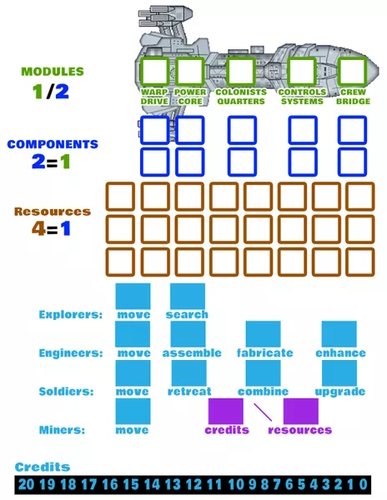 Now that we know how the basic premise and theme came around, how was a player supposed to achieve their objective of building a colony ship and launching it to win the game?
Now that we know how the basic premise and theme came around, how was a player supposed to achieve their objective of building a colony ship and launching it to win the game?
I know, let’s get them to make it from modules! Luckily for you guys, I am a digital packrat and I keep everything from my projects. I also iterate constantly and never overwrite ideas. This way if I decide I don’t like the path I’m on, I can back up to a previous layout and then go in another direction.
So, that leads us to the first player board. Here it is in all its glory. There were five modules to build. I ended up naming them Crew Bridge, Controls Systems, Colonists Quarters, Power Core, and Warp Drive. This set of modules would stick around all the way until late 2019 when I made a radical change… but more on that later.
These modules will serve not only as short-term goals toward the long-term objective but also as a visual reminder on the player board so other players can see who’s in the lead. It’s not necessarily a direct analog to points, but it’s certainly an indicator of where people are at on their overall objective. You can also see the first four unit types I decided to put into the game: Explorers, Engineers, Soldiers, and Miners. Only two of those have made it to the final version but three of them held on for a LONG time.
The idea here was that each module was made up of two components. Then, those components were each made up of four resources. You can see the trade ratio on the side. So technically there were modules, components, resources, and if you look at the bottom, credits. Now, don’t start planning an accounting degree just to hit the ground running. Almost NONE of that survived the next few major revisions. Again, more on that later.
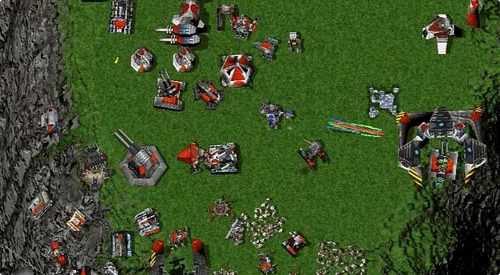 So, going into all of this, I knew the game was going to be a big concept for new players. However, I wanted it to be as accessible as possible. I have a low tolerance for games that I lovingly refer to as “rulebook flippers”, so that was definitely something I wanted to avoid with Cysmic. Rules overhead and complexity are fine as long as there are visual indicators to help the player out. This is how I started designing the game and how I drove the mechanics forward.
So, going into all of this, I knew the game was going to be a big concept for new players. However, I wanted it to be as accessible as possible. I have a low tolerance for games that I lovingly refer to as “rulebook flippers”, so that was definitely something I wanted to avoid with Cysmic. Rules overhead and complexity are fine as long as there are visual indicators to help the player out. This is how I started designing the game and how I drove the mechanics forward.
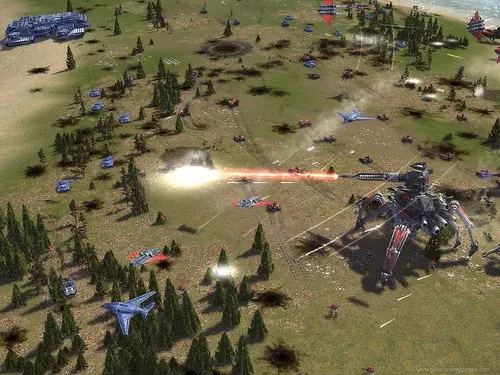 I have been a huge fan of old-school RTS games on the PC since the late 1990s. I played the standards like Command and Conquer and Warcraft/Starcraft…but my heart truly belonged to Total Annihilation, its successor Supreme Commander, and all of its iterations. Total Annihilation/Supreme Commander was RTS on a MASSIVE scale. You could literally have 1000 units at one time on the screen… PER PLAYER. It was amazing for the time compared to everything else out there.
I have been a huge fan of old-school RTS games on the PC since the late 1990s. I played the standards like Command and Conquer and Warcraft/Starcraft…but my heart truly belonged to Total Annihilation, its successor Supreme Commander, and all of its iterations. Total Annihilation/Supreme Commander was RTS on a MASSIVE scale. You could literally have 1000 units at one time on the screen… PER PLAYER. It was amazing for the time compared to everything else out there.
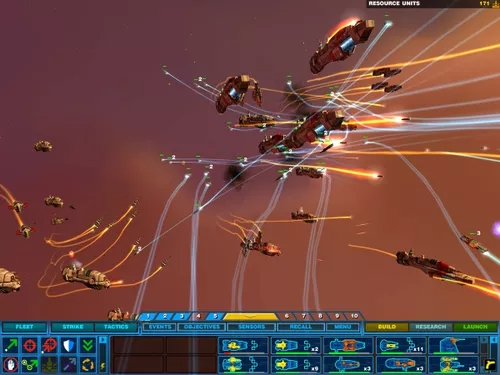 Another massive feature of these two franchises was the ability to view the entire war on a planetary scale and then zoom in all the way down to small skirmishes. Nearly all other RTS games on the market suffered from a fixed camera and field of view. The theme was nearly nonexistent in both games but the overall gameplay was amazing, so it didn’t matter a whole lot.
Another massive feature of these two franchises was the ability to view the entire war on a planetary scale and then zoom in all the way down to small skirmishes. Nearly all other RTS games on the market suffered from a fixed camera and field of view. The theme was nearly nonexistent in both games but the overall gameplay was amazing, so it didn’t matter a whole lot.
Later, I became obsessed with the Homeworld RTS series and the dark theme associated with it. Thematically, the homeworld feel and vibe is what drove my own style and theme, but the massive RTS scale approach from Total Annihilation/Supreme Commander is what drove the idea of tons of stuff on a board all at once — which is not as common in board games as it is in wargames. Command and Conquer - PC RTS GameI am guessing that this is typically price-driven but then again, there are lots of board games on the market such as the Zombicide series that have hundreds of minis in a box. It’s just sad that so many of them sit beside the gameboard rarely to be played with. If I am going to have a bunch of stuff to create an epic experience for players, then I want all of the players to be actually using their stuff!
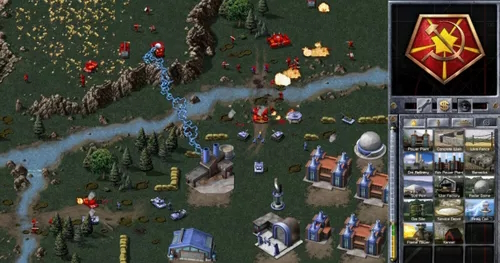 So, that idea is what set up my design choices for the overall gameplay…big board, large numbers of units per player in play, and lots of different tasks that the player can be doing at any given moment to be working towards their goal.
So, that idea is what set up my design choices for the overall gameplay…big board, large numbers of units per player in play, and lots of different tasks that the player can be doing at any given moment to be working towards their goal.
I made a list of units and their abilities that would be easy for new players to understand. Miners were the best resource gatherers and needed no explanation. In Command and Conquer, there was an alien mineral on Earth called Tiberium that was the resource of choice. I thought those were pretty cool as an “all-in-one” resource for the game. But, Miners can’t process the crystals themselves. Let’s make buildings and start off with the Refinery!
Of course, I needed Soldiers as they’re the base unit of any wargame. I also needed some kind of war machine and I like mechs. I mean, who doesn’t like mechs, right? So, the bigger, badder soldier had to be a big warmech.
I needed a way for players to get cards to drive the game and the easiest way to do that was through exploration of the planet. Exploration Cards became the standard card currency of the game. Then, I needed a unit to obtain those. How about Explorers? Perfect. But now there were three small units and two large units. The Explorer needed some sort of bigger analog vehicle. Let’s make a Transport. And that was my first setup. Everything seemed to have an obvious purpose and needed little to no explanation of what they should be doing for the player.
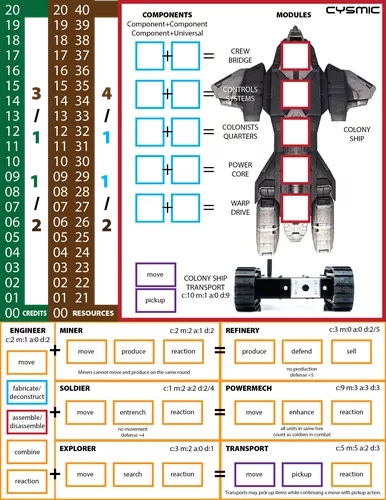 After that, it was time to make the player board and come up with the basic overview of currencies, resources, and how the player interacts with the units and the game. This is lovingly referred to as Cysmic Player Board 2.0. Little did I know that I would end up with literally HUNDREDS of player boards between 2017 and 2022.
After that, it was time to make the player board and come up with the basic overview of currencies, resources, and how the player interacts with the units and the game. This is lovingly referred to as Cysmic Player Board 2.0. Little did I know that I would end up with literally HUNDREDS of player boards between 2017 and 2022.
Following up on the ease of rules and visual indicators from earlier, I decided to try to find the best possible way to “upgrade” units into their larger counterparts. If you look closely, I use a simple equation. Engineer plus Miner equals Refinery. This works all the way across the board for the other large units. The idea was that any player could glance at their board and know that if you combine an engineer with any other personnel unit, you get the analog larger upgraded unit. This was something referred to by my gaming group as “wonder twin powers activate” which bothered me a bit because THIS WAS SERIOUS BUSINESS! LOL
Also, you can now see that I had color coding to match up tasks and I spelled out the basic unit abilities for each unit type. Needless to say, this board had MANY cubes on it that you would move around within those boxes.
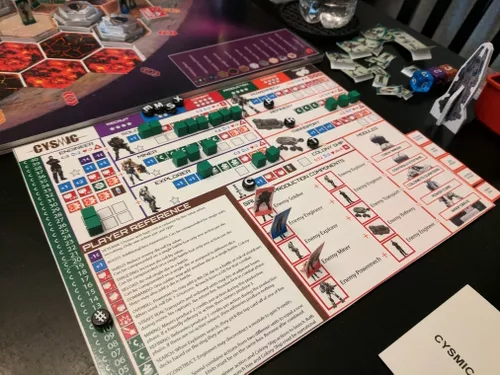 Early on, I thought cubes would be the easiest way to track stuff and choose actions. I actually dislike standard board game cubes as a personal preference because they are just boring and themeless and I wanted something better than that. But at this stage, I just thought “When in Rome…” and continued on with cubes.
Early on, I thought cubes would be the easiest way to track stuff and choose actions. I actually dislike standard board game cubes as a personal preference because they are just boring and themeless and I wanted something better than that. But at this stage, I just thought “When in Rome…” and continued on with cubes.
Another major design choice I made that I hadn’t seen before or since is the ability to activate all of the units of a given TYPE. I personally tend to get bored with big miniatures games where you activate one, maybe two units a turn. I feel like I never get much done and then the game ends before I get to play with all of the toys that the game provides.
So, in Cysmic, one of the earliest design decisions was to activate ALL of your units of a given type first. If you want to move a soldier, move ALL of your soldiers. You get the idea. This mechanic has lived through every iteration and has driven many of the other game decisions. It stuck with me so much because every turn feels big and epic which is what I was trying to capture.
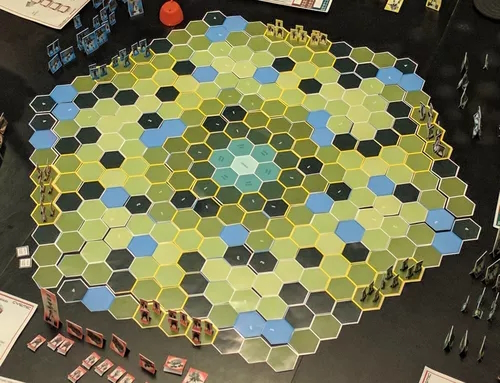 With all of that ground covered, what was the actual game board going to look like? Clearly, hexes were the way to go. I wanted to simulate a planet to help drive the point home that this is a massive game, while also using the board to show the planet cracking and crumbling away. But how do I actually make the planet fall apart and affect gameplay? Theme theme theme! How is that going to work?
With all of that ground covered, what was the actual game board going to look like? Clearly, hexes were the way to go. I wanted to simulate a planet to help drive the point home that this is a massive game, while also using the board to show the planet cracking and crumbling away. But how do I actually make the planet fall apart and affect gameplay? Theme theme theme! How is that going to work?
Well, if you read my last designer diary, you know I had ten layers of boards at first. So, out of practicality, I finally made a single-layer board and was planning to break away the edges. The board would get smaller and smaller as time went on, forcing players to interact more and more. This ended up being similar to the shrinking map of the battle royale games such as Fortnite, Apex Legends, or Call of Duty. I didn’t care for the comparison but it sort of worked. But then the board would get oddly misshapen and things didn’t work as well as I would have liked. Plus, it didn’t make total sense. There had to be a better way.
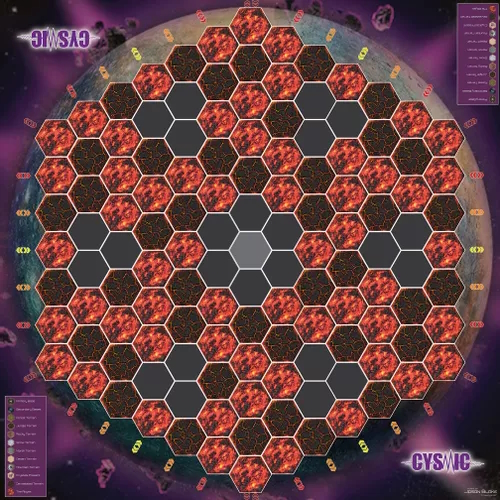 So, there I was back to the idea of 2 boards stacked on top of each other. The bottom board would be revealed to the players as the top board fell away. The top board would be individual hexes and the bottom board would be static. That was the only practical way to make it work. Plus, ironically, the static bottom board gave me a lot of flexibility on how things progressed as the top board fell away. Here is the earliest design iteration of the bottom board. The gray areas were designed so that the top layers would never fall away hence there being no need for graphics there as the players would never see them.
So, there I was back to the idea of 2 boards stacked on top of each other. The bottom board would be revealed to the players as the top board fell away. The top board would be individual hexes and the bottom board would be static. That was the only practical way to make it work. Plus, ironically, the static bottom board gave me a lot of flexibility on how things progressed as the top board fell away. Here is the earliest design iteration of the bottom board. The gray areas were designed so that the top layers would never fall away hence there being no need for graphics there as the players would never see them.
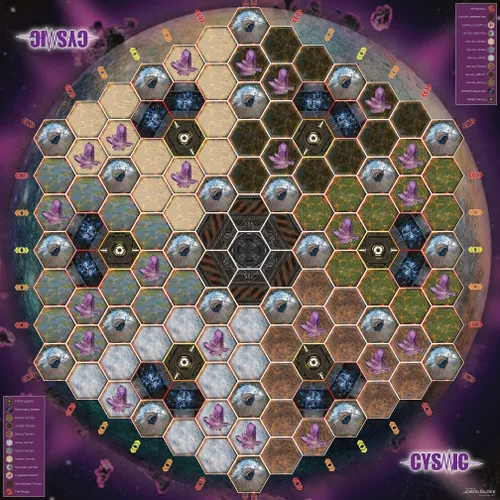 The top board was made up of six terrain types broken into pie slices. The center area was the last remaining launch pad to get your colony ship off of the planet. The 3 hexes within each terrain area were a static base where players would have the opportunity to start the game. The base and the launchpad were not affected by the collapsing hexes and were generally considered safe within the game mechanics. This was the design choice for the game board for several years. Again, we’ll look at when this was taken out of the game and replaced with something far more dynamic and thematic in a future design diary.
The top board was made up of six terrain types broken into pie slices. The center area was the last remaining launch pad to get your colony ship off of the planet. The 3 hexes within each terrain area were a static base where players would have the opportunity to start the game. The base and the launchpad were not affected by the collapsing hexes and were generally considered safe within the game mechanics. This was the design choice for the game board for several years. Again, we’ll look at when this was taken out of the game and replaced with something far more dynamic and thematic in a future design diary.
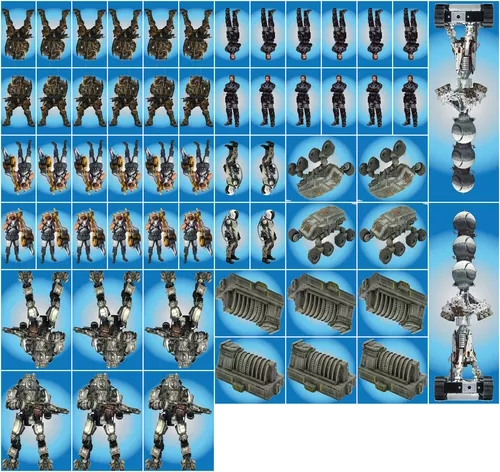 Having a working player board and game board was great. But, I had nothing to work with for the units themselves. I had been relegated to using little tokens with letters I bought at a hobby shop. Each letter stood for the type of unit. It was really basic. At this stage, I felt it was time to figure out how to get actual units on the board…but I was still being cheap and wanted to make it practical for little to no cost. So, here’s what I came up with. Cysmic - Blue Player PiecesI found some placeholder artwork online and used it to represent the units until I could find an artist. The idea was I could print out a single letter/A4 sized sheet of heavyweight paper. Then, I would cut out the individual units with two sides and fold them in the middle. If I flared out the bottom edges, it would serve as a stand. Finally, I made the same units in all six player colors. Here, we see the blue player version but all of the standard player colors were represented.
Having a working player board and game board was great. But, I had nothing to work with for the units themselves. I had been relegated to using little tokens with letters I bought at a hobby shop. Each letter stood for the type of unit. It was really basic. At this stage, I felt it was time to figure out how to get actual units on the board…but I was still being cheap and wanted to make it practical for little to no cost. So, here’s what I came up with. Cysmic - Blue Player PiecesI found some placeholder artwork online and used it to represent the units until I could find an artist. The idea was I could print out a single letter/A4 sized sheet of heavyweight paper. Then, I would cut out the individual units with two sides and fold them in the middle. If I flared out the bottom edges, it would serve as a stand. Finally, I made the same units in all six player colors. Here, we see the blue player version but all of the standard player colors were represented.
Once again, in theory this was a fantastic idea. It worked reasonably well and gave everyone the ability to understand the size and type of units represented on the board. Here’s a photo of the units actually on the board and some in the reserve of a player.
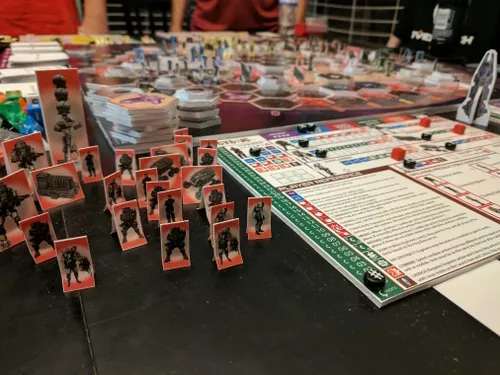 In practice, however, this was ridiculously frustrating and utterly impractical. Any slight air movement from ceiling fans or a hefty laugh at the table and the units would all fall down. Then, you had to remember where they were. All of them had to be stood back up. It was useful for playtesting and certainly got me seeing the game as a real game for once. But this made me want miniatures so bad I could taste it. So, we will visit that topic in a future designer diary.
In practice, however, this was ridiculously frustrating and utterly impractical. Any slight air movement from ceiling fans or a hefty laugh at the table and the units would all fall down. Then, you had to remember where they were. All of them had to be stood back up. It was useful for playtesting and certainly got me seeing the game as a real game for once. But this made me want miniatures so bad I could taste it. So, we will visit that topic in a future designer diary.
Now, amidst all of these iterations, I had refined the mechanics and designed a new player board…again. People seemed reasonably happy with the way the game was working. Remember how I said that I didn’t care for the standard 8mm cubes in games? Well, my latest player board was COVERED in them. How’s that for embracing the very thing you dislike?
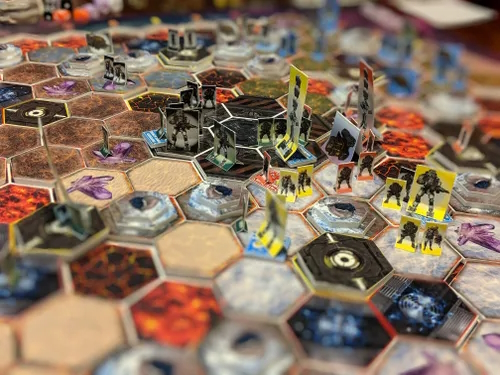 Without getting too heavy into the updated board mechanics, if you look closely you will see an embedded player aid under the section called PLAYER REFERENCE. I was committed to making sure that the game was fully playable without a rulebook as much as possible. You will also see a money track over to the left hand side. This board also shows the first major gameplay system of phases. Across the top of each player board was individual phases where each player would participate in the actions of that phase in turn order. The phases were: RECRUIT (put new units on the board), MOVE (move all of your units around), COMBAT (resolve all of the combats on the board), PRODUCTION (produce raw materials that equaled money then known as Kepler Kredits), COMBINE (remember wonder twin powers activate?), and finally TREMOR which is where the planet would collapse a section based on a roll of two six-sided dice. This design iteration was also the first time players would capture units to combine together to make the modules for their ship. I thought it was brilliant at the time but it made no sense thematically or mechanically. However, it just worked. We will deep dive more of these design choices in the next entry.
Without getting too heavy into the updated board mechanics, if you look closely you will see an embedded player aid under the section called PLAYER REFERENCE. I was committed to making sure that the game was fully playable without a rulebook as much as possible. You will also see a money track over to the left hand side. This board also shows the first major gameplay system of phases. Across the top of each player board was individual phases where each player would participate in the actions of that phase in turn order. The phases were: RECRUIT (put new units on the board), MOVE (move all of your units around), COMBAT (resolve all of the combats on the board), PRODUCTION (produce raw materials that equaled money then known as Kepler Kredits), COMBINE (remember wonder twin powers activate?), and finally TREMOR which is where the planet would collapse a section based on a roll of two six-sided dice. This design iteration was also the first time players would capture units to combine together to make the modules for their ship. I thought it was brilliant at the time but it made no sense thematically or mechanically. However, it just worked. We will deep dive more of these design choices in the next entry.
Regardless of my frustrations with certain elements, I thought the game had been playing well and was ready to demonstrate outside of my social circle and the select geographic region where I had been playtesting it. That’s right, it was time to attend my very first board gaming convention! I had never even been to one before. I knew virtually nothing about the inner workings of the industry. All I knew was that people brought games to conventions to try and get them published.
I did some research and heard about a program called UNPUB. They were hosting an event called PUBLISHER SPEED DATING at the closest convention to me which was within driving distance. So, I made arrangements to head to Dallas for BGG Con in the fall of 2017 with the game ready to show off. I dragged two of my closest friends to the convention to help me with the demonstration of the game (shoutout to Joe and David!). They were unbelievably helpful and kept me grounded while we were there. I wrote and memorized a script to repeat over and over to each interested publisher. I spent the entire week before the convention memorizing this whole script I will post here:
Cysmic is an epic sci-fi wargame in an Ameritrash style with some mild Euro elements. It plays 2-6 players at approximately 30 minutes per player for ages 12 and up.
The gameboard is unique in that it’s actually two layers deep and changes dynamically throughout the game. Not only that, the board is a planet so the movement wraps around the planet so you aren’t just fighting your two neighbors.
In Cysmic, there are no points. There is only the objective.
Be the first player to Construct your Colony Ship, move it to the Launchpad, then Launch it to win the game.
The primary way to build your Colony ship is to capture enemy units through combat and combine them into modules. Since this is the main way to win the game for every player, no one should feel bad about attacking their neighbors. Before I get to combining, let’s run through the gameplay.
Cysmic is set in rounds where each player takes a turn in the current phase and play continues clockwise. Each turn is over quickly so there is minimal downtime since that is a typical complaint about epic games. Each round is made up of 6 phases. Recruit is where you buy new units and add them to the board. Movement, you move your units and initiate combat. Combat is where you resolve the combat. Production… you get money and exploration cards. And then there is Combine…
Combine is one of the core mechanics of the game. This phase is built around this core mechanic to perform tasks like combining two small units to create a large one… for example, an Engineer combined with a Soldier nets you a Powermech. Then, more importantly, you have the captured enemy units combined together to create a colony ship module. Combine is the element that is the foundation of this game design.
Finally, there is the Tremor phase which is a really unique gameplay mechanic that I would like to demonstrate here. For the sake of this demo, this side is the current player one. Here ya go, roll this first D6 for me. That value determines the side where 1 is the current first player. Now, roll this second D6 for me. That value determines the ring counting inward. Now, remove the hexes belonging to that side and ring and destroy those units.
What you just saw is the Tremor Roll during the Tremor phase. Not only are the hexes randomly laid out differently each game, but the board changes dramatically each round. This is something you rarely see in epic games and is a huge selling point for Cysmic. It’s not a novelty either, it is fundamental to the gameplay.
The combat mechanics are interesting and go against tradition by favoring aggressive players more than defenders. The combat is turn-based and each turn is referred to as a strike. Each strike’s attrition is resolved before the next strike happens. Combat units are the only ones who can initiate combat… dictated here by this icon. The first combat unit in a hex is the player who attacks first. That’s what is called First Strike. Let’s look at an example. Here’s a scenario with 1 soldier and 2 miners. These two soldiers move in to the hex to attack. Since the defending player had a soldier on duty in this hex, he gets First Strike so he shoots first… however the miners don’t participate since it is assumed they were working. Then the Attacking player strikes with what’s left of his forces if any survived at all. Now, let’s take the soldier out of the first hex and replay that scene. The two attacking soldiers now have First Strike since the attacking player is the first in the hex with a Combat unit. He would now have first strike against the miners. It makes the idea of picking your battles an extremely strategic decision.
Normally, this would be a dull wargame and you would go through the motions to win the game. But the Exploration Cards in Cysmic is really where the game gets all its flavor from. You have three basic decks of combat, movement, and production cards to help move the game along. But the two wild card decks are Radical Tactics and Alien Artifacts. Both of these decks have wildly unpredictable cards that turn the game on its head with random acts of chaos usually played on other players.
There’s a billion more interesting parts of the game I could show you but let me open things up to you guys for questions before we run out of time.
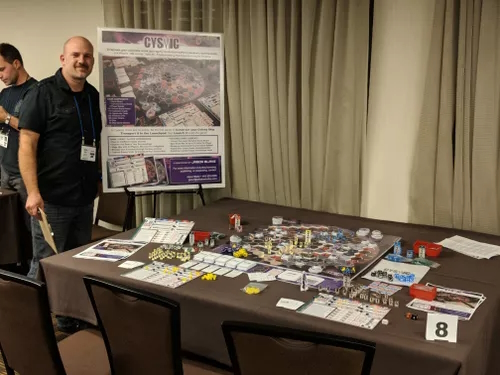 Many of the talking points here are still relevant now as I have been holding on to certain elements from day one. While combat is a bit different now, it is still turn-based and referred to as strikes. Also, the game still typically favors aggressors, but not as vividly. Cards are still very powerful and unpredictable and the tremor roll, now known as a fracture event, is one of the most exciting core gameplay principles.
Many of the talking points here are still relevant now as I have been holding on to certain elements from day one. While combat is a bit different now, it is still turn-based and referred to as strikes. Also, the game still typically favors aggressors, but not as vividly. Cards are still very powerful and unpredictable and the tremor roll, now known as a fracture event, is one of the most exciting core gameplay principles.
Along with the script, I also made my own banner, business cards, and even my own sell sheet for people to take with them. I felt prepared but simultaneously still had no idea what I was doing. When the Publisher Speed Dating had ended, I took the game out to the highest traffic freeplay area I could find and set it up. This ended up being a fantastic idea as the table presence brought people from all over the convention to see it. Even though I was a nobody, I had so many people lining up to play it or just try it out for a few turns based on the look of it alone.
All of my knowledge of trade shows came from a corporate background so I knew I had to make sure the presentation was solid and the game looked like a polished prototype. I had no idea what to expect or even what kind of questions were going to be asked by publishers. I didn’t even have an idea what to do if someone offered a publishing opportunity to me. Luckily, I didn’t think I needed to worry about it because I had read so often that games would get demonstrated for YEARS before ever having interest from a publisher. Now, it was just in the free play area for playtesting and getting extremely high levels of interest from all kinds of individuals in the industry and beyond. Many stories can be told from this convention about the interest I received but that’s a story for another time. In the next entry, I will be talking about the need to add actual miniatures to the game and what kind of proxies I ended up with at first. I will also be discussing the introduction of the game to larger audiences and the radical changes that followed that feedback. I hope you continue to follow along with me on this journey to relive all of the trials and tribulations to bring this game to life as I would like to present it to you in 2023. Until next time, thanks again for reading.
Jason Blake
Star Reach Games
CYSMIC
